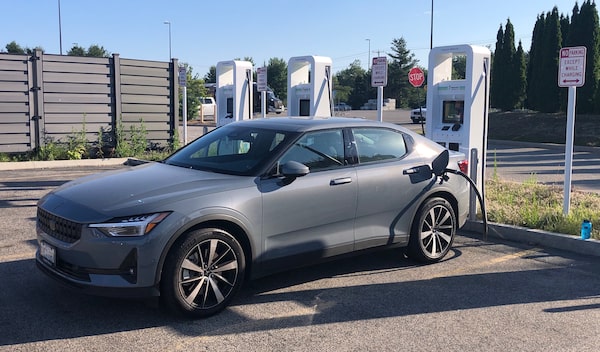
The Polestar 2 single-motor charging at an Electrify America station.Jeremy Sinek/The Globe and Mail
Some drivers have said in the comments section that an electric vehicle doesn’t work for them because they routinely drive 10 hours without stopping on long trips and therefore 450 or so kilometres of range isn’t enough.
We’re all different, and so are the trips we take, but I’m guessing that, for most of us, someone’s bladder or belly or boredom or butt pain will demand a break every few hours, even on the most epic get-there-or-bust voyages. Not to mention that regular leg-stretch breaks help keep us awake at the wheel.
That was the basis on which we opted to drive an electric vehicle 2,500 kilometres from Mississauga to the Maine coast and back this summer. We each had our own reasons: I wanted to write about long-hauling an EV; my wife hoped to put to rest her range/recharging anxiety that has so far deterred us from getting our own EV.
A single-motor Polestar 2 (we previously tested the dual-motor version) joined Polestar’s demo fleet at just the right time, and the Swedish automaker agreed to a longer-than-usual test drive.
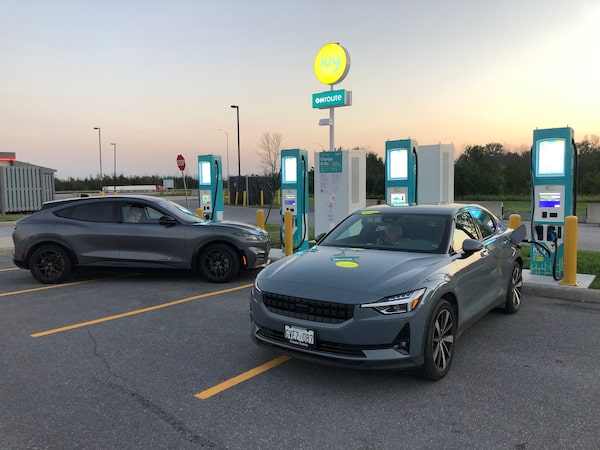
Charging at an OnRoute station along Highway 401 in Napanee, Ont.Jeremy Sinek/The Globe and Mail
The single-motor starts at $53,950 (though our fully optioned sample has a price of $64,350), qualifying it for the federal $5,000 incentive and various provincial ones. Its claimed range of 434 kilometres is competitive, and by all accounts more credible than some rivals’ claims.
The quickest route from the Toronto area to mid-coast Maine is driving east along the 401 and through Quebec’s eastern townships, crossing the border at Woburn, Que., just east of Sherbrooke. Of course, that was too simple for my family. We needed to detour via Port Colborne, Ont., on the north shore of Lake Erie, to drop off a relative, which committed us to the longer route south of Lake Ontario, through upstate New York and New England.
Before we left, I loaded my iPhone with charging-network apps, opened accounts, and added the excellent ChargeHub app that shows all public charging stations along your route. The Polestar also has the ChargePoint app in its Google-based infotainment system.
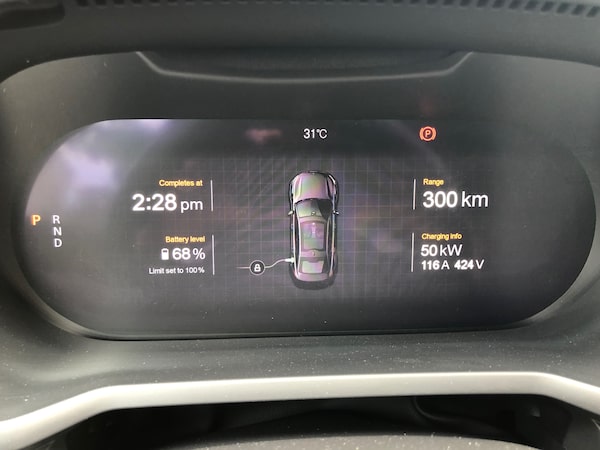
The Polestar 2 single-motor has a claimed range of 434 kilometres, but that claim seems more credible than some of its rivals.Jeremy Sinek/The Globe and Mail
With an overnight planned in Albany, N.Y., at a Hampton Inn with complimentary Level 2 charging, we could have done the 615-kilometre first leg with one recharge along the New York State Thruway – either at Waterloo Premium Outlets (326 kilometres from our starting point) with peace-of-mind range to spare, or cutting it more finely in the Syracuse area (390 kilometres).
As it turned out, dinner time and growling bellies mandated a stop near Rochester. Victor Crossing Mall provided an Electrify America station, plus – Naantastic, a terrific Indian fusion restaurant.
At a maximum rate of 91 kilowatts (well below the charger’s supposed 350-kilowatt capability), one hour of charging replenished our charge from 53 per cent (about 230 kilometres of range) to 95 per cent (420 kilometres).
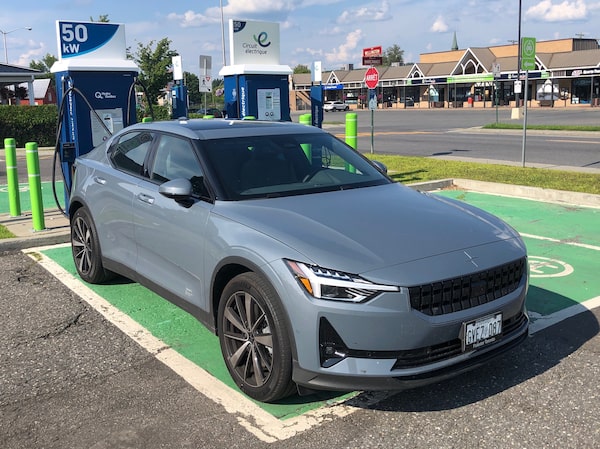
Charging in Coaticook, Que.Jeremy Sinek/The Globe and Mail
This stop set the tone for our trip. You can make plans based on the calculus of driving distances and charging-station locations, but where you actually end up charging may be dictated by bodily needs, overlaid by a peace-of-mind practice of charging when you can, not when you must.
We also started to learn that the Polestar seems to underpromise and overdeliver, even with the air conditioning running full-time.
When we started the remaining 330-kilometre, 110-kilometre-an-hour highway drive to Albany, the navigation predicted we’d arrive with an 8-per-cent charge remaining; we made it with 22 per cent.
After the Level 2 overnight charge, we resumed our trip with 96 per cent and 420 kilometres of range.
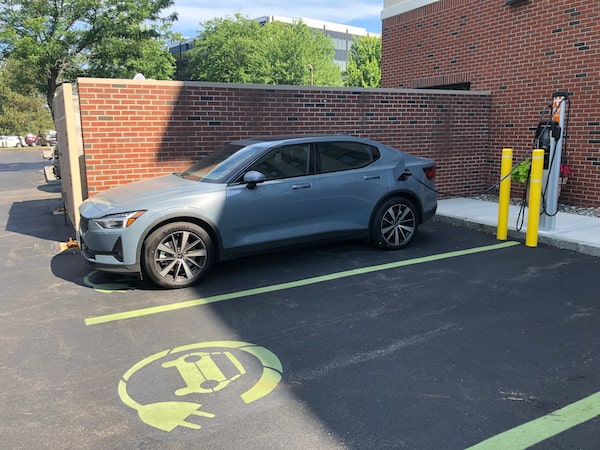
Charging at a hotel in Albany, NY.Jeremy Sinek/The Globe and Mail
Over each drive, the extrapolated range on a full charge (distance driven plus range remaining) remained consistent, usually between 450 and 470 kilometres. The Polestar is not like those EVs that show, say, 400 kilometres at the start, and then drop to 250 after only 100 kilometres of driving, at least in my experience on a summer day. (Routinely one shouldn’t charge to 100 per cent, but it’s acceptable on the occasional long trip, and we did so only when charging on 110 volts). Energy consumption ranged between 15 and 18 kilowatt hours per 100 kilometres for individual legs, and 16.8 over all.
With the help of ChargeHub, finding fast-charging stations involved some minor Plan-B adjustments, but no “running-on-ions” white-knuckle dramas. To use an EVGo station in Brattleboro, Vt., I downloaded the EVGo app, but it wouldn’t let a Canadian open an account, so a kind local EV driver “paid” for my charge on his card – it’s free for Vermont residents. This was the only time we had to wait to plug in, and then not long.
At Electrify America in Scarborough, Me., one charger cable couldn’t “talk” to the car, and on another charger, the card reader didn’t work, but third time lucky.
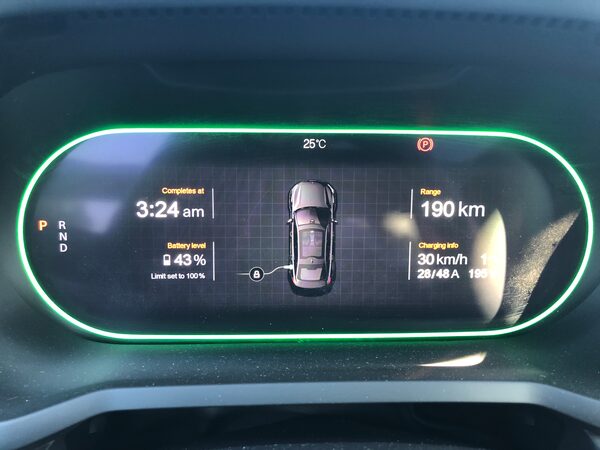
The number of kilometres of range left during a road trip to Maine.Jeremy Sinek/The Globe and Mail
In Belfast, Me., I created an account to use an EVConnect Level 2 at a restaurant, but I wasn’t charged for the hour spent adding 32 kilometres. Otherwise I relied on the 110-volt outlets at my brother’s place, where we were staying. We used his car for most of our longer day trips, so the Polestar’s charge was back up to 100 per cent in ample time for the trip home.
The initial 300 or so kilometres of scenic two-lane roads through the Maine and New Hampshire interior is a charging-station desert, but 324 kilometres of driving delivered us to a 50-kilowatt charger in Coaticook, Que., with 140 kilometres to spare. Thereafter, Quebec’s comprehensive Circuit Electrique network, plus expanding networks along Ontario’s 401 highway, made it largely plain sailing. The Petro-Canada station in Kingston, Ont., did let us down – the card reader didn’t work – but 20 kilometres down the road, a 20-minute session at an Ivy charging station at the Napanee, Ont., OnRoute highway rest stop added 100 kilometres, enough to get us home to Mississauga with 100 kilometres to spare.
We all have our stress points, and we all have different driving needs, but in our household, the long-distance issue is no longer a deal-breaker in our quest for the right electric car.
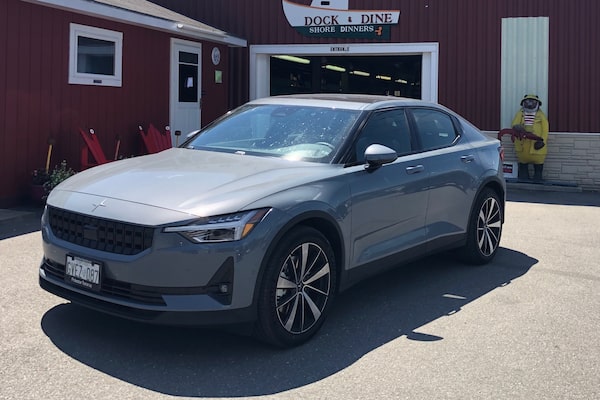
Parked in Belfast, Maine.Jeremy Sinek/The Globe and Mail
Polestar 2 performance
The gulf in performance between the 170-kilowatt single-motor Polestar 2 and the 350-kilowatt dual motor looks substantial on paper (acceleration to 100 kilometres an hour in seven seconds versus 4.4), but driving the single-motor off the track still delivers that effortlessly quick feel we love in EVs.
As a compact hatchback car (not an SUV), the Polestar is the right size and shape for us, and as a driver, I relish the lithe steering and handling, and long-haul comfort at the wheel. My wife, however, (who, admittedly, had a 10-pound dog on her lap for the duration) found her seat less hospitable, and we both found the ride harsh on sharp-edged bumps. The heat-pump climate control system coped admirably with the July heat, but surely the energy-saving heat pump should be standard, or a stand-alone option, not bundled into a $5,700 Plus Pack.
Shopping for a new car? Check out the Globe Drive Build and Price Tool to see the latest discounts, rebates and rates on new cars, trucks and SUVs. Click here to get your price.